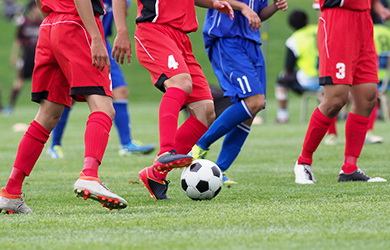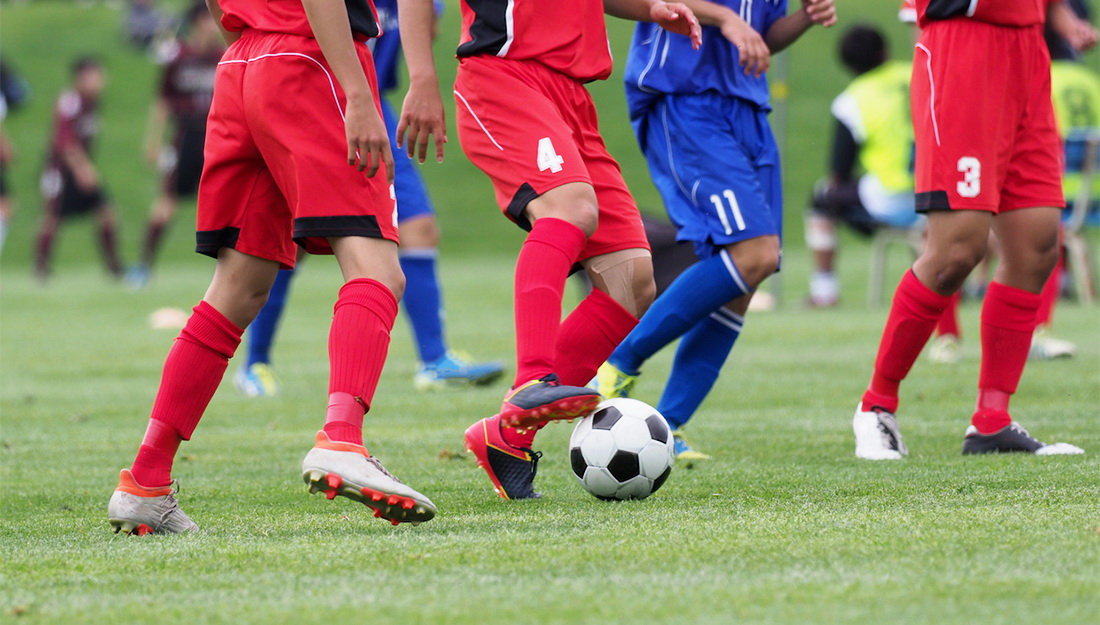
Ask A Pro, Get Answers | Soccer Ankle Sprain
Ask A Pro, Get Answers
Soccer Ankle Sprain

The latest Ask A Pro question comes from Mike who is suffering chronic ankle sprains from playing soccer. He's tried everything but nothing seems to be working.
Q:We are heading into soccer season and I’ve been prone to spraining my right ankle at least once every couple of months. I’ve done the regular rehabilitation such as rest, ice, and compression to heal the ankle, but it always seems to sprain again a month or so later. Whenever I feel like my ankle is going to roll, the front side of my right hip also seems to be really stiff. It even seems like if I were to step on a small rock, my ankle will roll. Are my ankles really weak because I’ve sprained it so many times? Is there a relation between the stiffness in my hip and the weakness of my ankle?
A:
Your chronic ankle sprains will both be related to your tight hip and your history of ankle sprains. Ankle ligaments do not heal back to their original length after a sprain so your ankle joint will be more unstable. The tightness in the hip can be due to a pelvic misalignment. It can either be caused by a tight muscle causing a pelvic rotation or vice versa. The misalignment may cause a functional leg length discrepancy where one leg is longer than the other which causes extra stress on the ankles.
Your body works in a way to always keep yourself upright. In order for the shorter leg to be equal with the longer leg, your body will cause you to walk with a more pronated gait on the right leg (think of it as walking on the lateral or outside portions of your right foot). This might explain why accidentally stepping on small rocks might cause your ankle to roll over so easily even after rehabilitation.
Solution:
Your body should be assessed for structural and functional deficits to adequately form a treatment plan. But in lieu of that, try picking up dynamic stretching before and after your sporting activity. Dynamic stretching works by the practitioner gently propelling their muscles towards their maximum range of motion. Motions like deep lunge walks forward and backwards, sumo squats, butt kicks, high knees will help to work your joints through the range of motion, stretch out the muscle and help prepare the muscle for work.
The therapists at Evolution Sport Therapy will be able to determine if your recurrent ankle sprains are due to a pelvic malalignment and will be able to assist you in designing a proper rehabilitation program once the root of the injury is identified and treated appropriately.
Jonathan Sun BPE, CAT(C)
Certified Athletic Therapist
Ask A Pro, Get Answers
Soccer Ankle Sprain

The latest Ask A Pro question comes from Mike who is suffering chronic ankle sprains from playing soccer. He's tried everything but nothing seems to be working.
Q:We are heading into soccer season and I’ve been prone to spraining my right ankle at least once every couple of months. I’ve done the regular rehabilitation such as rest, ice, and compression to heal the ankle, but it always seems to sprain again a month or so later. Whenever I feel like my ankle is going to roll, the front side of my right hip also seems to be really stiff. It even seems like if I were to step on a small rock, my ankle will roll. Are my ankles really weak because I’ve sprained it so many times? Is there a relation between the stiffness in my hip and the weakness of my ankle?
A:
Your chronic ankle sprains will both be related to your tight hip and your history of ankle sprains. Ankle ligaments do not heal back to their original length after a sprain so your ankle joint will be more unstable. The tightness in the hip can be due to a pelvic misalignment. It can either be caused by a tight muscle causing a pelvic rotation or vice versa. The misalignment may cause a functional leg length discrepancy where one leg is longer than the other which causes extra stress on the ankles.
Your body works in a way to always keep yourself upright. In order for the shorter leg to be equal with the longer leg, your body will cause you to walk with a more pronated gait on the right leg (think of it as walking on the lateral or outside portions of your right foot). This might explain why accidentally stepping on small rocks might cause your ankle to roll over so easily even after rehabilitation.
Solution:
Your body should be assessed for structural and functional deficits to adequately form a treatment plan. But in lieu of that, try picking up dynamic stretching before and after your sporting activity. Dynamic stretching works by the practitioner gently propelling their muscles towards their maximum range of motion. Motions like deep lunge walks forward and backwards, sumo squats, butt kicks, high knees will help to work your joints through the range of motion, stretch out the muscle and help prepare the muscle for work.
The therapists at Evolution Sport Therapy will be able to determine if your recurrent ankle sprains are due to a pelvic malalignment and will be able to assist you in designing a proper rehabilitation program once the root of the injury is identified and treated appropriately.
Jonathan Sun BPE, CAT(C)
Certified Athletic Therapist
Ask A Pro, Get Answers
Soccer Ankle Sprain

The latest Ask A Pro question comes from Mike who is suffering chronic ankle sprains from playing soccer. He's tried everything but nothing seems to be working.
Q:We are heading into soccer season and I’ve been prone to spraining my right ankle at least once every couple of months. I’ve done the regular rehabilitation such as rest, ice, and compression to heal the ankle, but it always seems to sprain again a month or so later. Whenever I feel like my ankle is going to roll, the front side of my right hip also seems to be really stiff. It even seems like if I were to step on a small rock, my ankle will roll. Are my ankles really weak because I’ve sprained it so many times? Is there a relation between the stiffness in my hip and the weakness of my ankle?
A:
Your chronic ankle sprains will both be related to your tight hip and your history of ankle sprains. Ankle ligaments do not heal back to their original length after a sprain so your ankle joint will be more unstable. The tightness in the hip can be due to a pelvic misalignment. It can either be caused by a tight muscle causing a pelvic rotation or vice versa. The misalignment may cause a functional leg length discrepancy where one leg is longer than the other which causes extra stress on the ankles.
Your body works in a way to always keep yourself upright. In order for the shorter leg to be equal with the longer leg, your body will cause you to walk with a more pronated gait on the right leg (think of it as walking on the lateral or outside portions of your right foot). This might explain why accidentally stepping on small rocks might cause your ankle to roll over so easily even after rehabilitation.
Solution:
Your body should be assessed for structural and functional deficits to adequately form a treatment plan. But in lieu of that, try picking up dynamic stretching before and after your sporting activity. Dynamic stretching works by the practitioner gently propelling their muscles towards their maximum range of motion. Motions like deep lunge walks forward and backwards, sumo squats, butt kicks, high knees will help to work your joints through the range of motion, stretch out the muscle and help prepare the muscle for work.
The therapists at Evolution Sport Therapy will be able to determine if your recurrent ankle sprains are due to a pelvic malalignment and will be able to assist you in designing a proper rehabilitation program once the root of the injury is identified and treated appropriately.
Jonathan Sun BPE, CAT(C)
Certified Athletic Therapist
Ask A Pro, Get Answers
Soccer Ankle Sprain

The latest Ask A Pro question comes from Mike who is suffering chronic ankle sprains from playing soccer. He's tried everything but nothing seems to be working.
Q:We are heading into soccer season and I’ve been prone to spraining my right ankle at least once every couple of months. I’ve done the regular rehabilitation such as rest, ice, and compression to heal the ankle, but it always seems to sprain again a month or so later. Whenever I feel like my ankle is going to roll, the front side of my right hip also seems to be really stiff. It even seems like if I were to step on a small rock, my ankle will roll. Are my ankles really weak because I’ve sprained it so many times? Is there a relation between the stiffness in my hip and the weakness of my ankle?
A:
Your chronic ankle sprains will both be related to your tight hip and your history of ankle sprains. Ankle ligaments do not heal back to their original length after a sprain so your ankle joint will be more unstable. The tightness in the hip can be due to a pelvic misalignment. It can either be caused by a tight muscle causing a pelvic rotation or vice versa. The misalignment may cause a functional leg length discrepancy where one leg is longer than the other which causes extra stress on the ankles.
Your body works in a way to always keep yourself upright. In order for the shorter leg to be equal with the longer leg, your body will cause you to walk with a more pronated gait on the right leg (think of it as walking on the lateral or outside portions of your right foot). This might explain why accidentally stepping on small rocks might cause your ankle to roll over so easily even after rehabilitation.
Solution:
Your body should be assessed for structural and functional deficits to adequately form a treatment plan. But in lieu of that, try picking up dynamic stretching before and after your sporting activity. Dynamic stretching works by the practitioner gently propelling their muscles towards their maximum range of motion. Motions like deep lunge walks forward and backwards, sumo squats, butt kicks, high knees will help to work your joints through the range of motion, stretch out the muscle and help prepare the muscle for work.
The therapists at Evolution Sport Therapy will be able to determine if your recurrent ankle sprains are due to a pelvic malalignment and will be able to assist you in designing a proper rehabilitation program once the root of the injury is identified and treated appropriately.
Jonathan Sun BPE, CAT(C)
Certified Athletic Therapist
© Copyright Evolution Sport Therapy 2022.
Newsletter Signup
Sign up for our newsletter to receive all the latest!
Newsletter Signup
Sign up for our newsletter to receive all the latest!
© Copyright Evolution Sport Therapy 2022.
Newsletter Signup
Sign up for our newsletter to receive all the latest!
© Copyright Evolution Sport Therapy 2022.